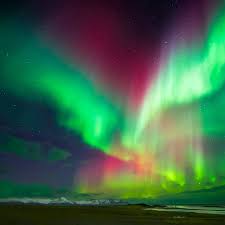The sun has been busy, and it’s been a mixed bag for radio amateurs. Earlier this month, millions of people got a chance to see the aurora borealis for the first time, as the northern lights were active farther south than they had been in decades. The brilliant displays, visible as far south as Mexico, were a result of a series of coronal mass ejections. The energy from our star interacted with particles in the upper atmosphere, causing them to glow in dancing curtains of multicolored light.
VHF aurora activity was up significantly, according to DX spotting clusters and activity heard on the air. The 2- and 6-meter bands were especially active, as the aurora acted like a reflector in the sky to enable signals to propagate much farther than they normally can on those bands.
G5 Storm Significantly Impacted Ionosphere
ARRL Central Division Director Carl Luetzelschwab, K9LA, is a leading expert on propagation. He’s provided the following analysis of the situation:
May 10, 11, and 12 of 2024 may go down as one of the greatest space weather storm periods of our lifetimes. It all started with two big sunspots in early May. These two big sunspots were identified as AR3663 (in the northern solar hemisphere) and AR3664 (in the southern solar hemisphere). AR stands for Active Region.
Both of these sunspot regions produced multiple M-class and X-class solar flares, which caused radio blackouts (signals were significantly attenuated) on the sunlit side of Earth. Typically, a radio blackout lasts for an hour or so, is most severe on the lower frequencies, and is due to the x-ray radiation from the solar flare increasing D-region absorption.
Not only did the big solar flares cause radio blackouts, they also caused solar radiation storms due to energetic protons that increased ionospheric absorption in the D region in the polar caps (the area inside the auroral ovals). Solar radiation storms can last for a couple of days and can result in degraded propagation on over-the-pole paths.
But the biggest impact to propagation started on May 8, when AR3664 released multiple Earth-directed CMEs (coronal mass ejections). CMEs manifest themselves as geomagnetic storms by significantly increasing the 3-hour K index. The K index indicates the activity of the Earth’s magnetic field and ranges from 0 (quiet) to 9 (extremely disturbed). The image (from https://www.swpc.noaa.gov/) shows the [data from May 10 – 12]. When the K index is this high for such a long time, the electron density in the F2 region of the ionosphere can be significantly depleted for days, not allowing higher frequencies to be propagated. On-the-air activity confirmed this.
In summary, early May was a very interesting period. We saw all three categories of disturbances to propagation — radio blackouts (x-ray radiation from solar flares), solar radiation storms (energetic protons from solar flares), and geomagnetic storms (elevated K indices).
FCC Opens Comments About CME Comms Impacts
The Federal Communications Commission’s Public Safety and Homeland Security Bureau wants to know if you noticed any impacts to radio communications during the storm. In a public notice, the FCC wrote:
To better understand the impacts of the geomagnetic storm on the U.S. communications sector, the Bureau is requesting information from communications service providers and the public regarding disruptions in communications between May 7 and 11, 2024, that it believes to be a result of the storm. The Bureau is encouraging commenters to provide any available evidence, particularly electromagnetic spectrum analyses, imagery, or chronological logs relating the storm’s impacts. Where possible, the Bureau asks that commenters include the description of the impacts; make and model of affected communications equipment, which could include transmitters, receivers, transceivers, switches, routers, amplifiers etc.; make, model, and type of affected antennae and their composition; frequencies affected; type and composition of cable adjoining communications equipment and the antennae, if applicable; duration of the impact; and any residual effects observed in the hours following restoration.
The public notice is at this link (PDF). Comments may be submitted using the FCC’s Electronic Comment Filing System (ECFS) at https://www.fcc.gov/ecfs and referring to PS Docket No. 24-161. ARRL’s guide to filing comments is at this link: https://www.arrl.org/arrl-guide-to-filing-comments-with-fcc












 Total views : 3300077
Total views : 3300077